Abstract
Lithium extraction from salt lake brine with a high mass ratio of Mg/Li by counter-current method using TBP-DIBK extraction system was investigated in this study. In the extraction process, TBP and DIBK acted as extractant, kerosene was used as diluent, and FeCl3 was used as co-extractant. The operation conditions of extraction, scrubbing, stripping, and regeneration were investigated. In this study, 5.5 mol/L LiCl + 0.5 mol/L HCl was used as a scrubbing solution for purifying products, and 6 mol/L HCl solution was used as a stripping agent to transfer Li+ from organic phase to aqueous phase. Furthermore, 2 mol/L NaOH and saturated MgCl2 were used as the regeneration agent to remove H+ from organic phase. The counter-current extraction experiments of 3-1-1-3 stages were carried out. After 10 cycles, the lithium extraction efficiency reached 99.90%; the separation factor of Li/Mg, Li/K, Li/Na, and Li/Ca was 5.215 × 104, 2.159 × 103, 3.659 × 102, and 3.104 × 102, respectively. The results indicated that the TBP-DIBK extraction system was effective at extracting lithium from salt lake brine with a high mass ratio of Mg/Li. Furthermore, the study of extraction thermodynamics suggested that lithium extraction was an exothermic process and that lower temperature promoted lithium extraction.
1. Introduction
Lithium and its compounds have many industrial applications, including glass ceramic, pharmaceutical, alloy, aerospace, nuclear reactor industries, and especially in rechargeable lithium-ion batteries (LIBS) for consumable electronics, electric vehicles (EVSs), and energy storage [1,2,3,4,5]. In recent years, the lithium product consumption for batteries has remarkably increased due to the extensive applications of rechargeable lithium batteries [6,7]. The surging demand for these applications necessitates the processing of all kinds of viable lithium resources. Lithium resources are mainly derived from brines and minerals [8,9,10]. Over 75% of lithium resources in China are contained in salt lake brines, and most of the salt lake brines have the characteristic of a high mass ratio of Mg/Li. Therefore, the separation of lithium and magnesium in salt lake brines is quite difficult. In order to recover lithium from brines, many technologies have been reported, including precipitation [11], electrodialysis [12], membrane [13], absorption [14,15], ion exchange, and solvent extraction [16,17,18,19,20,21]. Solvent extraction, which has been considered the most potentially viable industrial method, has the characteristics of high selectivity, simple operating process, low cost, and very high extraction efficiency.
The key to solvent extraction is to select an extraction system. A large number of studies have been done to optimize extraction systems that have the ability to extract lithium. Among them, TBP-FeCl3 had proved to be effective at extracting lithium from salt lake brine with a high mass ratio of Mg/Li [17,22]. However, there exist two critical issues that need to be resolved. One is the appearance of a third phase in the process of extracting lithium, which has a bad influence on the extraction process. The other is the solubility of the extraction system, which cannot be ignored in actual production. In our previous works [23,24], EA, BA, MIBK, DIBK, and N523 were mixed with TBP in the organic phase to extract lithium from salt lake brine. Results indicated that the phase interface was clear after extraction, and no third phase appeared in the process of extraction. Furthermore, the solubility of organic agents was tested. The solubility experiments manifested the solubility rank of EA, MIBK, DIBK, and TBP in different concentrations of magnesium chloride, which was as follows: MIBK > EA > TBP > DIBK. The soluble of organic reagents decreased with the further increase in the concentration of MgCl2. Therefore, DIBK would be the better organic agent added to TBP extraction systems in terms of the solubility and phase separation effect.
In this paper, DIBK was added to an organic solution owing to its low solubility and economy, and TBP, DIBK, and kerosene were used as organic solution to extract lithium from salt lake brine. The craft parameters of extraction, scrubbing, stripping, and regeneration were confirmed by experiments. Lithium extraction efficiency and the separation factor of Li/Mg were calculated. Furthermore, the extraction thermodynamics was also investigated.
2. Experimental
2.1. Chemicals and Instruments
Aqueous solution was prepared by LiCl·H2O, MgCl2·6H2O, FeCl3·6H2O, and HCl. The salt lake brine was obtained from Qinghai Xitaijinaier, and its major components are listed in Table 1 and Table 2. The main instruments are also listed in Table 3. The organic solution was prepared by TBP, DIBK, and kerosene.

Table 1.
Main chemical reagents.

Table 2.
Major components in brine.

Table 3.
Main instruments.
2.2. Experiments Data
Firstly, the organic solution and aqueous solution were mixed via a separating funnel at phase ratio of O/A = 2 except for the phase ratio experiments. Then, the funnel was oscillated in a shaker at room temperature for 10 min, and two phases were kept for 30 min to separate the phases after shaking. The aqueous phase after extraction was released from the outlet at the lower part of the separating funnel, and the loaded organic phase was poured out from the upper part of the separating funnel when the two phases were separated completely. The metal ion concentration in aqueous phase after extraction was too high to analyze. Therefore, the aqueous solution needed to be diluted before analyzing metal ion concentrations, and the loaded organic phase needed to be transferred by stripping process.
The lithium extraction efficiency (E) and the distribution ratio (D) of metal ions could be calculated according to Equations (1) and (2).
where ci and ce (g/L) represented the metal ion concentration in initial aqueous solution and equilibrium aqueous solution, respectively. Vaq and Vorg (mL) represented the volume of aqueous solution and organic solution, respectively. D represented the distribution ratio of metal ion concentration in organic solution and aqueous solution.
2.3. Experiments Analysis
The atomic absorption spectrometer (AAS) (A30, Pgeneral, Beijing, China) and inductivity coupled plasma-atomic emission spectrometry (ICP-OES) (ICP-6500, Thermo Fisher Scientific, Fresno, CA, USA) were used to analyze the metal ion concentration in aqueous solution. The aqueous solution obtained by experiment was firstly diluted, and then metal ion concentration was measured using AAS and ICP-OES. Li+ concentration in aqueous solution could be obtained via the method mentioned above. However, the concentration of other metal ions in the aqueous solution after extraction could not be measured directly by AAS and ICP-OES because of the higher concentration. Mass conservation was used to determine the concentration of other metal ions in aqueous solution after extraction. That is to say, the concentration of other metal ions in organic phase was firstly stripped to aqueous solution and then measured by AAS and ICP-OES. The concentration of other metal ions in aqueous solution after extraction was calculated by mass conservation.
3. Results and Discussion
3.1. Determination of Experiment Parameters
3.1.1. Effect of HCl Concentration in Aqueous Solution
According to the extraction mechanism of TBP-FeCl3 extraction system, H+ had the stronger binding capacity with FeCl4− and TBP than that of Li+ and Mg2+ [21,24]. Therefore, the high HCl concentration in aqueous solution was a disadvantage for lithium extraction. FeCl3 played the part of co-extractant in the process of extracting lithium by TBP-FeCl3 extraction system. Fe (III) would be hydrolyzed when the HCl concentration in aqueous phase was too low. It was necessary to study the effect of the HCl concentration in aqueous solution on lithium extraction.
In the experiment, the organic solution was 30% TBP + 30% DIBK + 40% kerosene, the aqueous solution was 0.288 mol/L LiCl + 0.375 mol/L FeCl3 + 4 mol/L MgCl2, and the extraction phase ratio of O/A = 2. The experimental results of the effect of HCl concentration in aqueous solution are shown in Figure 1. It was obvious that the Li+ and Mg2+ concentrations in organic phase and lithium extraction percentage decreased with the increase in HCl concentration in aqueous solution. Additionally, the separation factor of Li/Mg first increased then decreased with the increase in HCl concentration in aqueous solution. That was due to the increase in HCl concentration in aqueous solution being a disadvantage to lithium extraction. However, when the HCl concentration exceeded 0.15 mol/L, Mg2+ entered the organic phase more easily than Li+ because of the ultrahigh concentration of Mg2+. Hence, the HCl concentration in aqueous solution needed to promote lithium extraction efficiency was determined to be 0.05 mol/L.
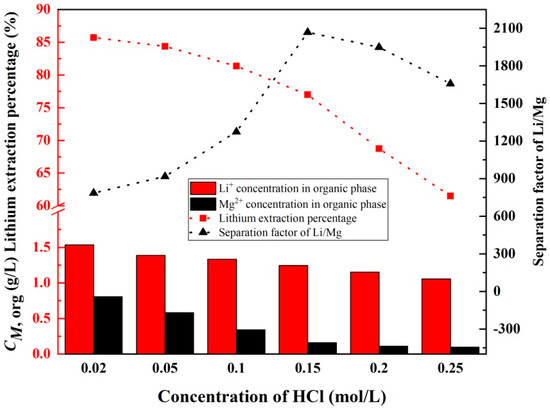
Figure 1.
Effect of HCl concentration in aqueous solution.
3.1.2. Effect of Concentration of TBP and DIBK in Organic Phase
In our previous report [23], TBP and DIBK demonstrated the ability to extract lithium; both can be used as extractants in the extraction process. The volume ratio of TBP/DIBK and the total concentration of TBP and DIBK in organic solution were investigated.
In the experiment, the aqueous solution was 0.288 mol/L LiCl + 0.375 mol/L FeCl3 + 4 mol/L MgCl2, the organic solution consisted of TBP, DIBK, and kerosene, and the extraction phase ratio of O/A = 2. Figure 2a shows the effect of the volume ratio of TBP/DIBK on lithium extraction. It can be seen that the Li+ concentration in organic solution and lithium extraction percentage significantly increased with the increasing volume ratio of TBP/DIBK and reached 1.93 g/L and 92% at the volume ratio of TBP/DIBK = 1/1. With further increasing of TBP/DIBK, the Mg2+ concentration in organic solution and separation factor of Li/Mg decreased. The effect of the volume ratio of Vs/V on lithium extraction is shown in Figure 2b. When the volume ratio of Vs/V reached 70%, the Li+ concentration in organic phase and the lithium extraction percentage were nearly steady. The Mg2+ concentration in organic phase was observed to rise when the volume ratio of Vs/V ranged from 70~100%. The separation factor of Li/Mg increased greatly when the volume ratio of Vs/V ranged from 40~70%. There was little change in the lithium extraction percentage and separation factor of Li/Mg when further increasing the volume ratio of Vs/V. Considering the lithium extraction efficiency and the separation factor of Li/Mg, the volume ratio of TBP/DIBK was fixed at 1/1, and the volume ratio of Vs/V was determined to be 70%.
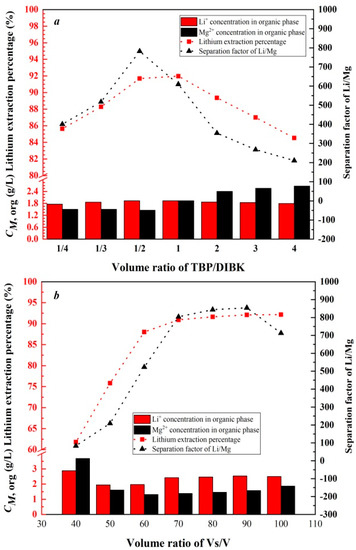
Figure 2.
Effect of TBP and DIBK in organic phase. ((a) means the effect of volume ratio of TBP/DIBK and (b) means the effect of volume ratio of Vs/V. Vs means the total concentration of TBP and DIBK in organic solution, V means the total concentration of TBP, DIBK, and kerosene in organic solution).
3.1.3. Effect of the Molar Ratio of Fe/Li
Since FeCl3 was the co-extractant, the molar ratio of Fe/Li played an important role in lithium extraction. In the experiment, the aqueous solution was 0.288 mol/L LiCl+ + 4 mol/L MgCl2, the organic solution consisted of 35% TBP + 35% DIBK + 30% kerosene, and the extraction phase ratio of O/A = 2. The effect of the molar ratio of Fe/Li on lithium extraction was studied, and the experimental results are given in Figure 3. Figure 3 shows that a higher molar ratio of Fe/Li was an advantage for the lithium extraction. Meanwhile, Mg2+ was in competition with Li+. The Mg2+ concentration in organic solution increased significantly because of the ultrahigh concentration of Mg2+ in aqueous solution as the Fe/Li molar ratio increased. Furthermore, the separation factor of Li/Mg decreased. The lithium extraction percentage reached 84%, and the separation factor of Li/Mg achieved the maximum value of 1121 when the molar ratio of Fe/Li was 1. Therefore, the molar ratio of Fe/Li in aqueous solution was 1 in the following experiment.
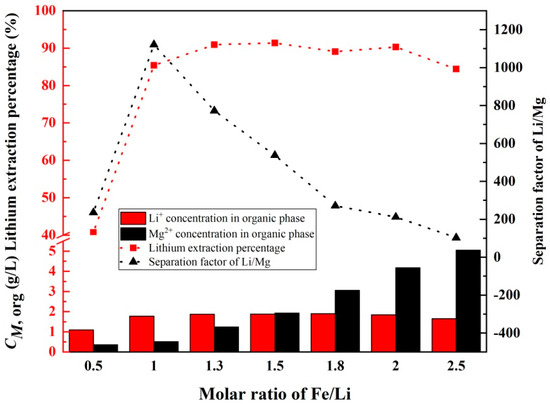
Figure 3.
Effect of the molar ratio of Fe/Li.
3.1.4. The Effect of the Phase Ratio of O/A
In the experiment, the aqueous solution was 0.288 mol/L LiCl+ +4 mol/L MgCl2, the organic solution consisted of 35% TBP + 35% DIBK + 30% kerosene, and the extraction phase ratio of O/A was 1/2, 1/1, 2/1, 5/1, 10/1, 20/1. The effect of the phase ratio of O/A is shown in Figure 4. It is clear from Figure 4 that the Li+ and Mg2+ concentration in organic solution increased with the increase in the phase ratio of O/A. However, the Mg2+ concentration in organic phase increased much faster than Li+. At phase ratio of O/A = 2/1, the lithium extraction percentage reached 92%, and separation factor of Li/Mg was 671. When the phase ratio of O/A was over 2/1, the phase separation time became longer and the Li+ concentration in organic solution decreased. From an economical and operational point of view, the phase ratio of O/A = 2/1 would be suitable.
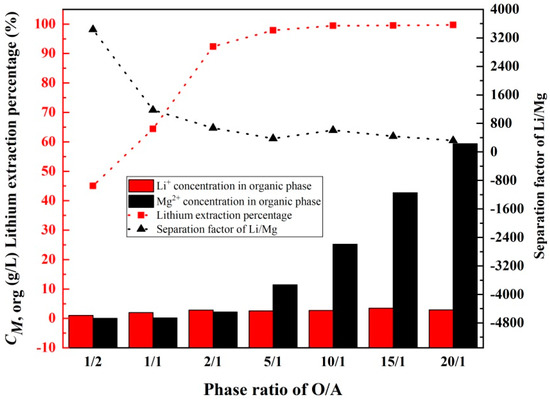
Figure 4.
Effect of the phase ratio of O/A.
In optimum experimental conditions, the organic solution was 35% TBP + 35% DIBK + 30% kerosene, the aqueous solution was 0.288 mol/L Li+ and 4 mol/L MgCl2, and the organic solution extracted Li+ from aqueous solution at the phase ratio of O/A = 2/1. In order to achieve more than 90% Li+ from aqueous phase, three theoretical stages were required from the lithium extraction McCabe–Thiele diagram (Figure 5).
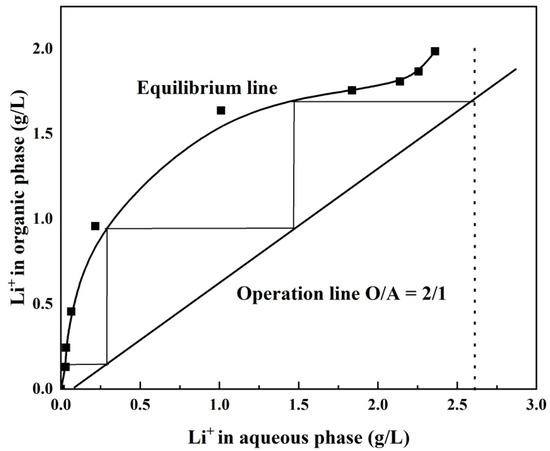
Figure 5.
McCabe–Thiele graphical method to determine the theoretical stage.
3.1.5. Determination of Scrubbing Condition
In the process of lithium extraction, the other metal ions that were untargeted ions could be extracted to organic phase, which led to the purity of the lithium product not being good. To obtain a pure lithium product, it was necessary to scrub the other metal ions. In the scrubbing experiment, the organic phase obtained after three stages of extraction was used as the organic solution; different concentrations of LiCl and 0.5 mol/L HCl were used as the scrubbing liquor, which avoided the hydrolysis of Fe (III); and the scrubbing phase ratio of O/A = 10/1. The effect of the scrubbing solution of LiCl and HCl is given in Figure 6a. The results show that the concentration of Na+, K+ Ca2+, and Mg2+ was relatively low when the concentration of LiCl was 5.5 mol/L. Meanwhile, the Li+ concentration in scrubbing showed no significant change with a higher concentration of LiCl. The scrubbing liquor was determined to be 5.5 mol/L LiCl and 0.5 mol/L HCl.
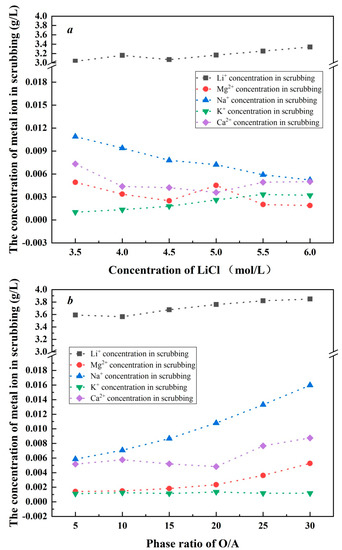
Figure 6.
Effect of scrubbing condition. ((a) means the effect of concentration of LiCl and (b) means the effect of phase ratio of O/A).
The phase ratio of scrubbing in actual production was crucial. In this experiment, the organic phase obtained after three stages of extraction was used as the organic solution, and 5.5 mol/L LiCl and 0.5 mol/L HCl was used as the scrubbing liquor. The effect of the scrubbing phase ratio of O/A is shown in Figure 6b. It can be seen that when the phase ratio of scrubbing was above 15, concentrations of Na+, K+, Ca2+, and Mg2+ in scrubbing increased. From the perspective of lithium concentration and scrubbing efficiency, the phase ratio of O/A was determined to be 15:1.
3.1.6. Optimization of Stripping Condition
In the stripping process, the organic solution obtained after scrubbing was used as the organic solution, HCl was treated as the stripping agent due to the extraction sequence of H+ being extracted before Li+ in the extraction process, and the stripping phase ratio of O/A = 2/1. Figure 7a shows that the Li+ concentration in stripping solution exhibited no differences with the increases in HCl concentration. Fe3+ concentration in stripping solution decreased at the concentration of HCl ranged from 0~6 mol/L, which meant that Fe (III) was lost from the loaded organic phase to aqueous phase. When the HCl concentration was over 6 mol/L, there was nearly no Fe3+ in aqueous phase. The results show that 6 mol/L HCl would be preferable for the stripping solution.
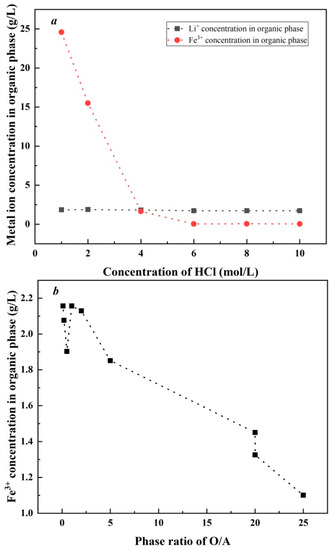
Figure 7.
Effect of stripping condition. ((a) means the effect of concentration of HCl and (b) means the effect of phase ratio of O/A).
The organic solution obtained after scrubbing was used as an organic solution, and 6 mol/L HCl was treated as the stripping agent. The effect of the stripping phase ratio was studied, and the results are shown in Figure 7b. Figure 7b shows that the Li+ concentration in stripping solution demonstrated no obvious change when the phase ratio of O/A ranged from 1/2~5/1. With the further increase in the phase ratio, the Li+ would be notably lost. The phase ratio of O/A in stripping was determined to be 5:1.
3.1.7. Investigation of Regeneration Condition
The metal ions were almost stripped by 6 mol/L HCl at the stripping phase ratio of O/A = 5:1. Owing to the high bonding capacity of H+ over the other metal ions, the organic phase in the lithium extraction performance would be significantly limited when the stripped organic phase was used in extraction process without the removal of H+. In the previous study, 2 mol/L NaOH and saturated MgCl2 were used as the regeneration solution. The process was called saponification when NaOH was used as the regeneration solution. When MgCl2 was used as the regeneration solution, the process was called inversion. In the regeneration process, the stripped organic phase was regenerated by 2 mol/L NaOH and saturated MgCl2 at the different phase ratio of O/A. In order to detect the extraction ability of the organic phase after regeneration, fresh brine was used as the aqueous phase to contact with the regenerated organic phase. The effect of the regeneration phase ratio is shown in Figure 8. The results suggest that the behavior of the organic phase regenerated by inversion and saponification made no clear difference to the lithium extraction performance. From an economical and environmental viewpoint, inversion was better than saponification. Further, inversion would not bring impurities to aqueous phase. However, inversion could not remove the H+ of stripped organic phase completely. Considering the advantages of inversion and saponification, the regeneration condition should be first inversion–saponification–second inversion.
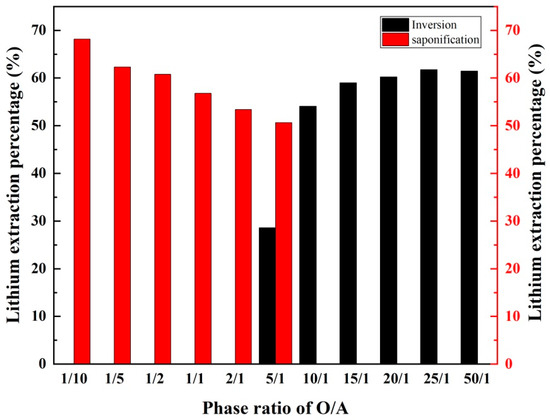
Figure 8.
Effect of regeneration phase ratio.
3.2. Counter-Current Extraction Experiments
The operation conditions of extraction, scrubbing, stripping, and regeneration process are presented in Table 4, and a process diagram is given in Figure 9. The organic phase loaded 0.375 mol/L Fe3+ and consisted of 35% TBP + 35% DIBK + 30% kerosene, a salt lake brine that was adjusted according to the components given in Table 2 was used as the aqueous phase, and the extraction phase ratio of O/A was 2/1. In the scrubbing process, 5.5 mol/L LiCl and 0.5 mol/L HCl were used as the scrubbing agent at the phase ratio of O/A = 15/1. The aqueous solution after scrubbing was mixed with brine and used as the aqueous solution in the extraction section. In the stripping process, 6 mol/L HCl was used as the stripping agent at the phase ratio of O/A = 20/1. Part of the aqueous solution after stripping was used as the scrubbing solution. In the regeneration process, 2.0 mol/L NaOH and saturated MgCl2 were treated as the regeneration solution. Ten cycles of experiments were carried out, until the extraction experiment reached equilibrium.

Table 4.
Operation conditions of counter-current extraction.

Figure 9.
Process diagram of counter-current extraction.
The lithium extraction percentage and the separation factor of Li+ and the other metal ions are listed in Table 5. It could be calculated that lithium extraction reached 99.90%, and the separation factor of Li/Mg, Li/K, Li/Na, and Li/Ca was 5.215 × 104, 2.159 × 103, 3.659 × 102, and 3.104 × 102, respectively. The third phase did not appear in the process of the whole extraction. The results indicated that the TBP-DIBK extraction system was effective for the extraction of lithium from salt lake brine with a high mass ratio of Mg/Li.

Table 5.
The extraction percentage and separation factor.
3.3. The Analysis of FTIR Spectrum
FTIR spectroscopy was used to determine the information for different functional groups, which could present small differences in the chemical microenvironment. Thus, the interactions between metal ions and organic reagents could be clarified by FT-IR spectroscopy.
The organic phase obtained in the whole process was characterized by FTIR spectroscopy, and the FTIR spectrum of the organic phase is shown in Figure 10. In Figure 10, 1280 cm−1 peaks were determined to be the characteristic peak of P=O in TBP. The peak showed red shift in varying degrees during the process of extraction–scrubbing–stripping–regeneration; this was due to the electron transfer between metal ions and P=O in TBP when the chemical reaction occurred in organic phase and aqueous phase. The transfer of electrons would lead to the vibration frequency moving in the low frequency direction. Based on operation of the counter-current extraction experiment, the conversion relationship of cations in organic phase could be described, as shown in Figure 11. The organic phase loaded ion was mostly Li+, except for a little Mg2+ in the process of extraction. Most of the ions loaded in the organic phase turned out to be Li+ after scrubbing by 5.5 mol/L LiCl + 0.5 mol/L HCl. Therefore, there was no change in the peak of P=O in the organic phase after extraction and scrubbing. The functional group of TBP P=O also demonstrated a red shift after stripping by 6 mol/L HCl due to the H+ loaded in the organic phase. In the process of regeneration, the organic phase loaded Mg2+ after the first inversion, then the metal ion in the load organic phase changed from Mg2+ to Na+ after saponification by NaOH, and the organic phase loaded Mg2+ again after the second inversion. Since the binding capacity of Na+ and Mg2+ with P=O in TBP was almost equal, there was no signification in the peak of P=O in the process of regeneration.
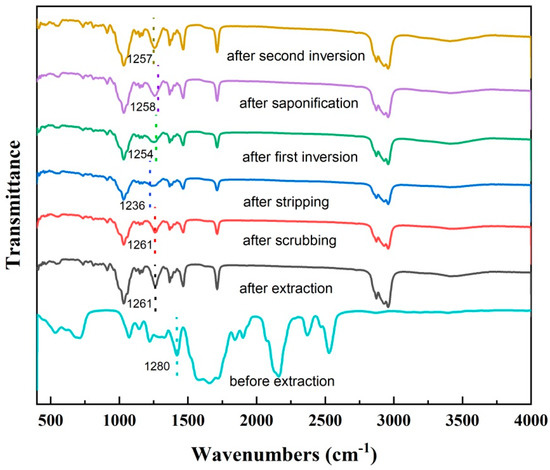
Figure 10.
FTIR spectra of organic phases.

Figure 11.
The conversion relationship of positive ions in organic phase.
3.4. The Study of Thermodynamics Parameters
Thermodynamic parameters represented a crucial factor to studying the extraction mechanism. The experiments on lithium extraction by TBP-DIBK extraction system were carried out at various temperatures.
Van’t Hoff revealed the relationship between enthalpy change (ΔH), extraction temperature, and the distribution ratio of Li+. Therefore, ΔH could be calculated by Equation (4).
where R was the universal gas constant, T was the absolute temperature (K), and C was the integration constant.
On the basis of Equation (4), there was a linear relationship between lgD and 1/T. Figure 12 shows that the slope of the linear relationship was 139.75, and the reaction enthalpy ΔH could be calculated as −11.93 kJ/mol. This meant that lower temperature was an advantage for lithium extraction. The fluidity of organic phase was poor, and the phase separation was difficult when the temperature was low. Therefore, room temperature (293 K) would be appropriate for lithium extraction.
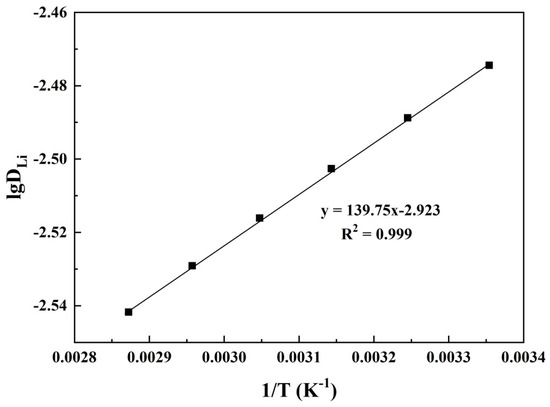
Figure 12.
The relationship of lgD and 1/T.
4. Conclusions
The extraction of lithium from salt lake brine with a high mass ratio of Mg/Li by counter-current method using a TBP-DIBK extraction system was investigated in this paper. In the extraction process, DIBK was added to organic solution owing to its low solubility and economy, TBP and DIBK acted as extractant, kerosene was used as diluent, and FeCl3 was used as co-extractant. The operation conditions of extraction, scrubbing, stripping, and regeneration were investigated. In this study, 5.5 mol/L LiCl + 0.5 mol/L HCl was used as the scrubbing solution for purifying the product, and 6 mol/L HCl solution was used as the stripping agent to transfer Li+ from organic phase to aqueous phase. Furthermore, 2 mol/L NaOH and saturated MgCl2 were used as the regeneration agent to remove H+ from organic phase. The counter-current extraction experiments of 3-1-1-3 stages were carried out. After 10 cycles, the lithium extraction percentage reached 99.90%, the separation factor of Li/Mg, Li/K, Li/Na, and Li/Ca was 5.215 × 104, 2.159 × 103, 3.659 × 102, and 3.104 × 102, respectively. The results indicated that the TBP-DIBK extraction system was effective at extracting lithium from salt lake brine with a high mass ratio of Mg/Li. Furthermore, the extraction thermodynamics study revealed that lithium extraction was an exothermic process and that lower temperatures promoted lithium extraction.
Author Contributions
Writing, H.L.; supervision, L.L. and W.L.; project administration, H.L. All authors have read and agreed to the published version of the manuscript.
Funding
This work was funded by CAS “Light of West China” program and Qinghai Kunlun Elite High-end Innovation and Entrepreneurship Talent Project.
Conflicts of Interest
The authors declare no conflict of interest.
References
- Zhang, Y.; Sun, W.; Xu, R.; Wang, L.; Tang, H. Lithium extraction from water lithium resources through green electrochemical-battery approaches: A comprehensive review. J. Clean. Prod. 2021, 285, 124905. [Google Scholar] [CrossRef]
- Bosch, P.; Contreras, J.P.; Munizaga-Rosas, J.; Saavedra-Rosas, J. Feasibility and cost minimisation for a lithium extraction problem. Comput. Oper. Res. 2020, 115, 104724. [Google Scholar] [CrossRef]
- Lei, S.; Sun, W.; Yang, Y. Solvent extraction for recycling of spent lithium-ion batteries. J. Hazard. Mater. 2022, 424, 127654. [Google Scholar] [CrossRef] [PubMed]
- Wesselborg, T.; Virolainen, S.; Sainio, T. Recovery of lithium from leach solutions of battery waste using direct solvent extraction with TBP and FeCl3. Hydrometallurgy 2021, 202, 105593. [Google Scholar] [CrossRef]
- Xiao, J.; Jia, Y.; Shi, C.; Wang, X.; Yao, Y.; Jing, Y. Liquid-liquid extraction separation of lithium isotopes by using room-temperature ionic liquids-chloroform mixed solvent system contained benzo-15-crown-5. J. Mol. Liq. 2016, 223, 1032–1038. [Google Scholar] [CrossRef]
- Masmoudi, A.; Zante, G.; Trébouet, D.; Barillon, R.; Boltoeva, M. Solvent extraction of lithium ions using benzoyltrifluoroacetone in new solvents. Sep. Purif. Technol. 2021, 255, 117653. [Google Scholar] [CrossRef]
- Liu, C.; Lin, J.; Cao, H.; Zhang, Y.; Sun, Z. Recycling of spent lithium-ion batteries in view of lithium recovery: A critical review. J. Clean. Prod. 2019, 228, 801–813. [Google Scholar] [CrossRef]
- Sterba, J.; Krzemień, A.; Fernández, P.R.; García-Miranda, C.E.; Valverde, G.F. Lithium mining: Accelerating the transition to sustainable energy. Resour. Policy 2019, 62, 416–426. [Google Scholar] [CrossRef]
- Kuang, G.; Liu, Y.; Li, H.; Xing, S.; Li, F.; Guo, H. Extraction of lithium from β-spodumene using sodium sulfate solution. Hydrometallurgy 2018, 177, 49–56. [Google Scholar] [CrossRef]
- Ooi, K.; Sonoda, A.; Makita, Y.; Chitrakar, R.; Tasaki-Handa, Y.; Nakazato, T. Recovery of lithium from salt-brine eluates by direct crystallization as lithium sulfate. Hydrometallurgy 2017, 174, 123–130. [Google Scholar] [CrossRef]
- Zhang, Y.; Hu, Y.; Wang, L.; Sun, W. Systematic review of lithium extraction from salt-lake brines via precipitation approaches. Miner. Eng. 2019, 139, 105868. [Google Scholar] [CrossRef]
- Melnikov, S.; Sheldeshov, N.; Zabolotsky, V.; Loza, S.; Achoh, A. Pilot scale complex electrodialysis technology for processing a solution of lithium chloride containing organic solvents. Sep. Purif. Technol. 2017, 189, 74–81. [Google Scholar] [CrossRef]
- Zante, G.; Boltoeva, M.; Masmoudi, A.; Barillon, R.; Trébouet, D. Lithium extraction from complex aqueous solutions using supported ionic liquid membranes. J. Membr. Sci. 2019, 580, 62–76. [Google Scholar] [CrossRef]
- Zhu, X.; Yue, H.; Sun, W.; Zhang, L.; Cui, Q.; Wang, H. Study on adsorption extraction process of lithium ion from West Taijinar brine by shaped titanium-based lithium ion sieves. Sep. Purif. Technol. 2021, 274, 119099. [Google Scholar] [CrossRef]
- Xue, F.; Wang, B.; Chen, M.; Yi, C.; Ju, S.; Xing, W. Fe3O4-doped lithium ion-sieves for lithium adsorption and magnetic separation. Sep. Purif. Technol. 2019, 228, 115750. [Google Scholar] [CrossRef]
- Li, H.-F.; Li, L.-J.; Peng, X.-W.; Ji, L.-M.; Li, W. Extraction kinetics of lithium from salt lake brine by N,N-bis(2-ethylhexyl) acetamide using Lewis Cell. Hydrometallurgy 2018, 178, 84–87. [Google Scholar] [CrossRef]
- Li, H.-f.; Li, L.-j.; Li, W. The extraction rules investigation of mental (Li, Na, K, Mg, Ca) ion in salt lake brine by TBP-FeCl3 extraction system. Chem. Phys. Lett. 2021, 763, 138249. [Google Scholar] [CrossRef]
- Li, H.-f.; Li, L.-j.; Li, W.; Zhou, Y.-q. The key factors and mechanism study on lithium extraction by TBP-FeCl3 extraction system. Chem. Phys. Lett. 2020, 754, 137740. [Google Scholar] [CrossRef]
- Shi, D.; Cui, B.; Li, L.; Peng, X.; Zhang, L.; Zhang, Y. Lithium extraction from low-grade salt lake brine with ultrahigh Mg/Li ratio using TBP–kerosene–FeCl3 system. Sep. Purif. Technol. 2019, 211, 303–309. [Google Scholar] [CrossRef]
- Zhang, L.; Li, L.; Shi, D.; Li, J.; Peng, X.; Nie, F. Selective extraction of lithium from alkaline brine using HBTA-TOPO synergistic extraction system. Sep. Purif. Technol. 2017, 188, 167–173. [Google Scholar] [CrossRef]
- Shi, D.; Zhang, L.; Peng, X.; Li, L.; Song, F.; Nie, F.; Ji, L.; Zhang, Y. Extraction of lithium from salt lake brine containing boron using multistage centrifuge extractors. Desalination 2018, 441, 44–51. [Google Scholar] [CrossRef]
- Ji, L.; Hu, Y.; Li, L.; Shi, D.; Li, J.; Nie, F.; Song, F.; Zeng, Z.; Sun, W.; Liu, Z. Lithium Extraction with a Synergistic System of Dioctyl Phthalate and Tributyl Phosphate in Kerosene and FeCl3. Hydrometallurgy 2016, 162, 71–78. [Google Scholar] [CrossRef]
- Li, H.-F.; Li, L.-J.; Ji, L.-M.; Peng, X.-W.; Li, W. The extraction ability and mechanism in extraction lithium by several organic extractants. Chem. Phys. Lett. 2019, 733, 136668. [Google Scholar] [CrossRef]
- Li, H.; Li, L.; Peng, X.; Ji, L.; Li, W. Selective recovery of lithium from simulated brine using different organic synergist. Chin. J. Chem. Eng. 2019, 27, 335–340. [Google Scholar] [CrossRef]
Disclaimer/Publisher’s Note: The statements, opinions and data contained in all publications are solely those of the individual author(s) and contributor(s) and not of MDPI and/or the editor(s). MDPI and/or the editor(s) disclaim responsibility for any injury to people or property resulting from any ideas, methods, instructions or products referred to in the content. |
© 2022 by the authors. Licensee MDPI, Basel, Switzerland. This article is an open access article distributed under the terms and conditions of the Creative Commons Attribution (CC BY) license (https://creativecommons.org/licenses/by/4.0/).